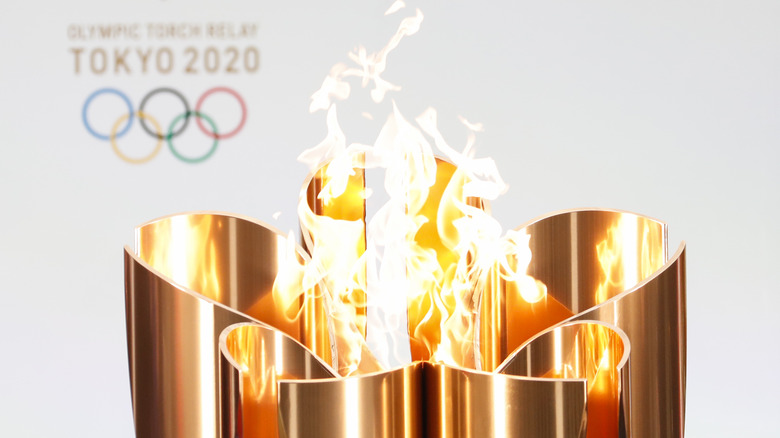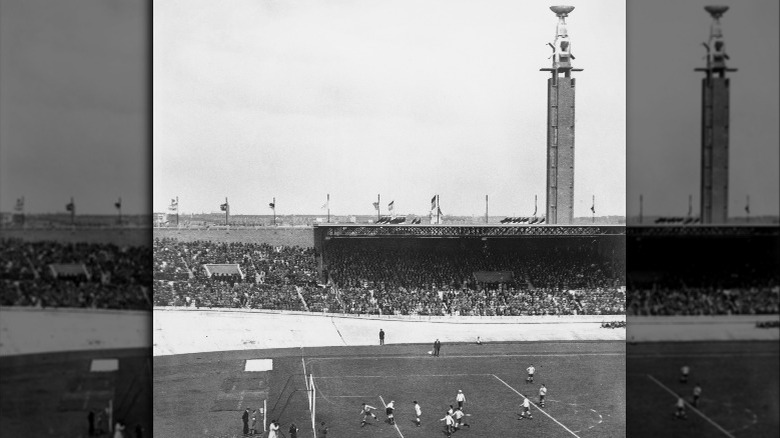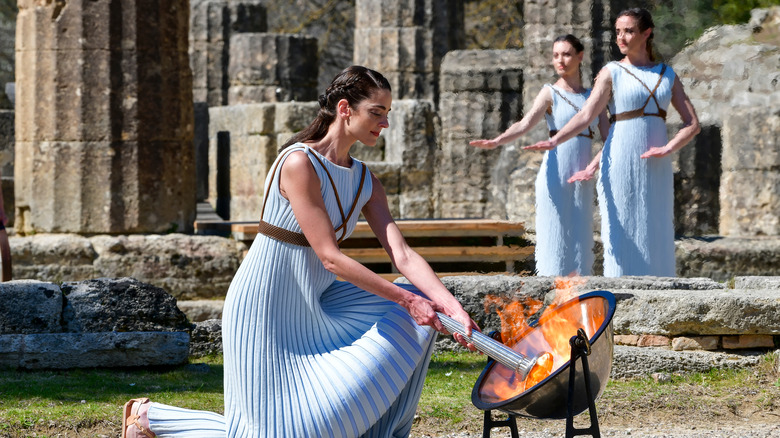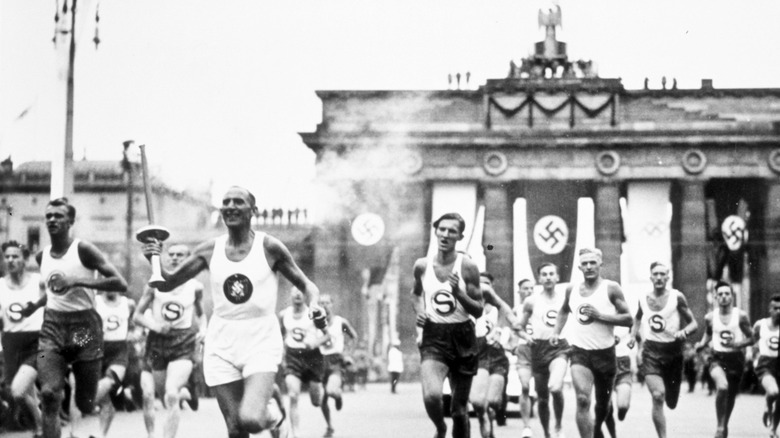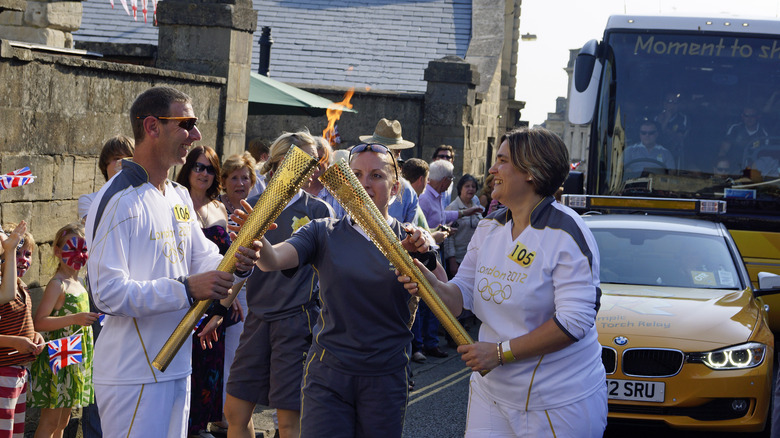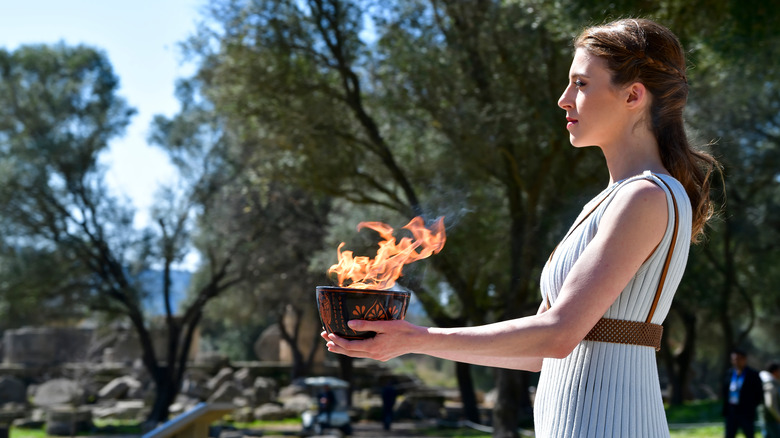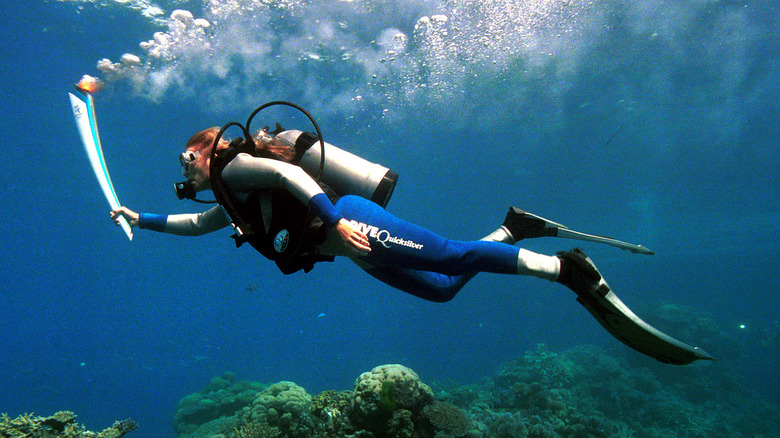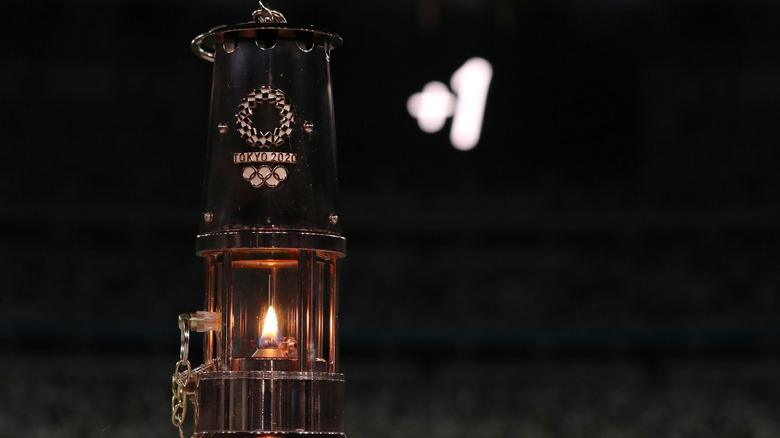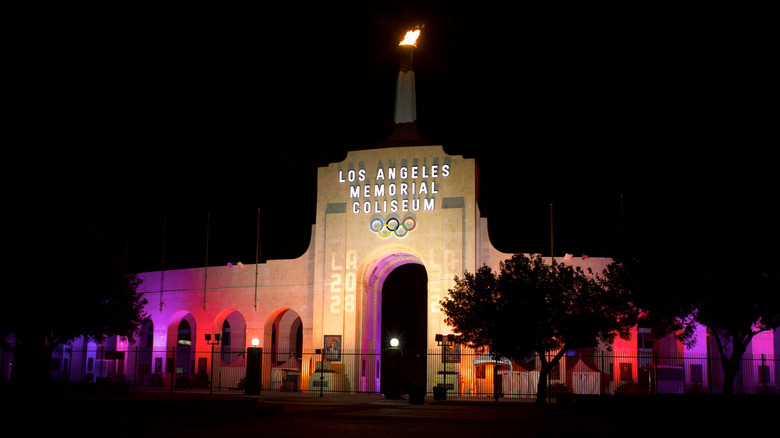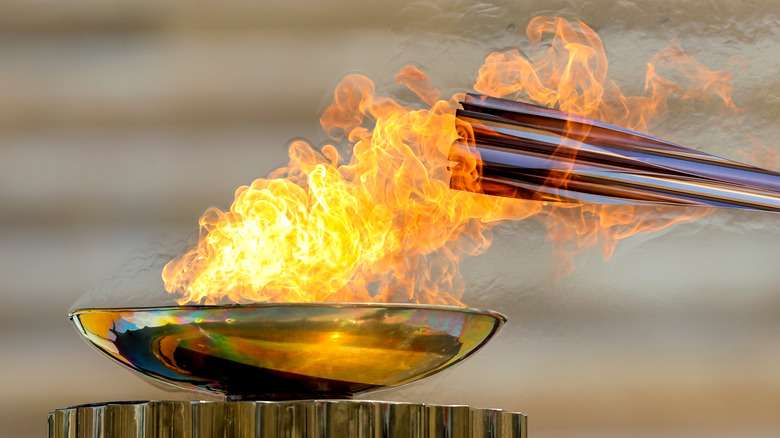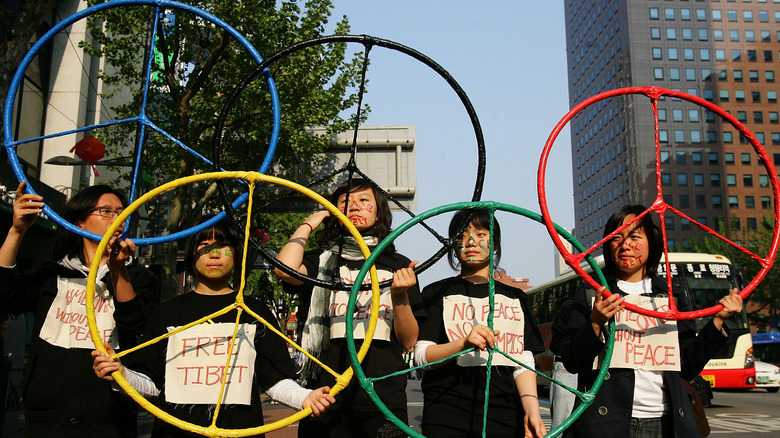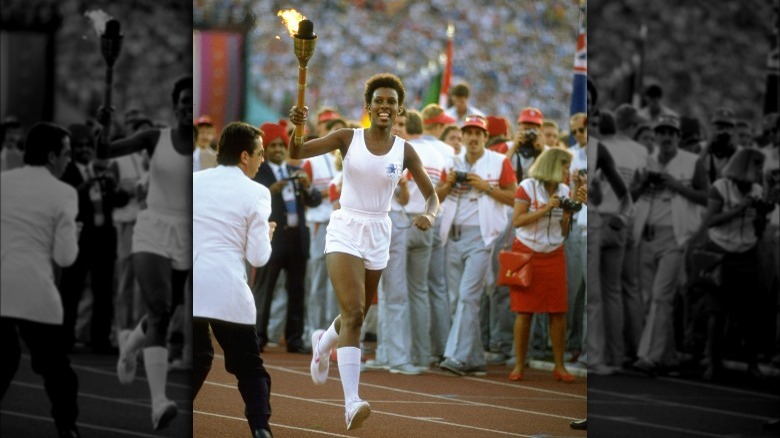The Untold Truth Of The Olympic Flame
The symbols of the Olympics are famous worldwide. Of course, there are the five rings, but there's also the iconic Olympic flame. Burning bright throughout the Games, the flame is a tradition passed down from the ancient Olympics.
Fire meant a lot to the ancient Greeks. Per Greek myth, flame was given to humanity by Prometheus, who stole it from the gods to help humankind progress. Fire was something sacred and literally divine, so it was always kept burning throughout the Olympics as a way to honor that story. The flames were kept burning at the altars of the goddesses Hestia and Hera, and the god Zeus — further ways to honor the gods.
In modern times, those altars don't exist anymore, but the tradition of the ever-burning Olympic flame still lives on. It may not directly reference the old myth of Prometheus anymore, but it still ties the past and present together. Though that's not to say the modern Olympic flame hasn't had some stories of its own.
The 1928 Olympic Games first started the Olympic flame
The Olympic flame is a pretty iconic symbol to the modern Olympic Games, but one that sort of disappeared for a while, along with the Olympics themselves. That said, the flame didn't come back with the actual Games.
The modern Olympic Games saw their revival in 1896 in Athens, but not all of the traditions we associate with the Olympics were around at that point, including the idea of having a flame burn for the entirety of the Games (via International Olympic Committee). That particular tradition wouldn't come about until the 1928 Olympics in Amsterdam introduced the Olympic flame to the modern world. According to Sport-Olympic, the idea came from the architect who was working on the Games — Jan Wils. There aren't a lot of details, but the stadium was designed to be overlooked by a tower — at the time called the "Marathon tower" and later known to locals as the "KLM Ashtray" — which could house the flame. And so, on July 28, an employee from the Amsterdam Electric Board became the first person in the history of the modern Olympic Games to light the now-iconic Olympic flame. Then this spectacle really became a tradition four years later, with the 1932 Los Angeles Games lighting a flame of their own.
The Olympic flame is lit by the Sun
The Olympic flame isn't just any old flame, given the symbolism and importance it holds. Because of that, though, it can't be lit by just any common lighter or match. There's actually a whole ceremony for it that takes place in Olympia, Greece — one that makes use of some pretty cool science dating from antiquity.
Basically, parabolic mirrors are the name of the game. According to Smithsonian Magazine, parabolic mirrors are rounded dishes that are really good at concentrating light. By standing it out in the sun, it reflects the rays of light into one particular spot; in perfect, ideal conditions, that one little area could theoretically reach something close to 10,000 degrees Fahrenheit. At that temperature, it's no real problem to light a flame just by concentrating rays of light. (In reality, 10,000 degrees isn't exactly doable, and cloudy days make this whole process a little less predictable. The priestesses running the ceremony usually prepare a back-up flame in the days before the official ceremony, just in case the clouds roll in.)
This technique isn't a new thing, though. It's been around since ancient Greece — Archimedes supposedly made use of the method against a fleet of ships — and provides a fire lit purely by the power of the sun.
The torch relay was originally Nazi propaganda
Even once the idea of the Olympic flame was introduced into the modern Olympic Games, the new ceremonies weren't done yet. The torch relay was still to come, and, yup, it was created by the Nazis.
Berlin being awarded the honor of hosting the 1936 Olympics was sort of muddied a little by, well, the rise of Hitler a few years earlier (via History). Hitler himself actually didn't really like the Olympics but was convinced into hosting because of the publicity that the event could bring to Nazi Germany. When it came to the torch relay, though, that pretty much came from the mind of one man: Carl Diem, the organizer of the Games. He pictured a long, unbroken line of runners, linking ancient Olympia to Berlin, with the flame carried by torches of German make.
Ultimately, though, the Nazi party saw the opportunity to turn this idea into a clever bit of political theatre and propaganda; they pumped funds into the torch relay and used it as a show of power, Nazi supporters showing up in cities that the torch passed through. Plus, Hitler, for his dislike of the modern Olympic Games, did admire ancient Greek athletes and used their image to promote Nazi ideals of supremacy and perfection (via ABC News). It makes sense that the last runner in the chain — Fritz Schilgen — was chosen to light the cauldron because of his Aryan appearance.
What's it like being part of the torch relay?
Sure, yeah, when the Olympics roll around, there are always all the pictures of celebrities and famous athletes carrying the torch. But did you know that running with the torch isn't just a matter of being famous? Prior to the 1970s, being a torchbearer involved being a young male athlete, but since then, the qualifications have opened up. Actually, according to Olympics.com, totally normal people can be torchbearers! Mostly, organizers are looking for inspirational people within local communities — people who represent positive qualities like tolerance, unity, and perseverance. And those people can come from anywhere, regardless of age, nationality, gender, and the like; diversity is the goal.
That said, the first and last runners are a little different. They're usually sporting giants in the host country (via Quartz) or people whose presence can send strong messages. The Olympic Museum mentions the last torch-bearers in 1964 and 2000 as notable: Yoshinori Sakai, the last runner for the 1964 Games, was born in Hiroshima on the day the atomic bomb dropped; Cathy Freeman, the last runner for the 2000 Sydney Games, represented the country's Aboriginal community.
As for security? That's also taken care of. For the 2020 Tokyo Games, a group of security runners trained to accompany the torchbearers and protect the flame, ready to make sure nothing could ruin the experience (via Olympics.com).
Sometimes, the Olympic flame is lit outside of Olympia
Alright, so even though it's true that tradition tends to say that the Olympic flame starts its journey in ancient Olympia, that doesn't mean that every single Olympic Game has actually had its flame lit there. For one, the earlier Olympics, like the 1928 Amsterdam and 1932 Los Angeles games both had their flames just lit on site, as per ABC News. After all, there wouldn't be any sort of torch relay to get it to the host city from Olympia for another couple of years.
But the lack of a torch relay isn't the only reason why the flame wouldn't be lit in Olympia. The 1952 Winter Games in Oslo ended up being another example of that, with the flame being lit in Morgedal, Norway (via Olympics). As for why? Well, instead of a flame meant to commemorate the ancient Greek Olympics, this was meant to honor the origins of skiing. The torch relay began in the home of a Norwegian skiing legend and was carried as a "symbolic Nordic" flame, rather than an Olympic flame — one that was also a reference to Norwegian skiers using torches to find their way in the dark.
The Olympic flame has been transported in weird ways
With the Olympic torch relay being a tradition for decades, there have, of course, been a number of pretty unique ways to transport it. Add into that the fact that the torch has had to make it all around the globe, crossing oceans, and, well, the Olympic flame has moved around via strange methods.
For one, in the 1976 Games, the flame had to make it from Athens to Ottawa, and while boats and planes were definitely options, the organizers decided to take a decidedly less-than-conventional approach. According to the LA Times, the flame was moved by a satellite. The flame, still in Athens, was used to trigger an electronic pulse, and that pulse was sent across the ocean. Once it arrived in Ottawa, it turned on a laser beam, which relit the flame. Sure, it's kind of a weird way to claim that the same flame travelled from Greece to Canada, but it's still counted.
For another fun one, you can take a look at something more recent. In the year 2000, the Olympic flame took a trip underwater at the Great Barrier Reef. Per BBC, a special torch was created, carrying a chemical that burned at really high temperatures (more than two thousand degrees Celsius). With that, the flame worked more like a flare, one which kept water from entering and ruining the torch while simultaneously looking like the iconic flame, even while underwater.
The Olympic flame has gone to space
In 2014, the Olympic flame took a longer trip than it ever had in the past: from Earth to space. Okay, to be entirely fair, the 2014 Sochi Games torch wasn't entirely trailblazing. According to Space.com, two other torches had gone up beforehand — one in 1996 and another in 2000 — which were either replicas of the torch, or were, at least, unlit.
2014 was different, though. NASA reports that the Olympic torch officially took its journey into the cosmos on a Russian Soyuz rocket, which brought it onto the International Space Station. There, the nine crewmembers got to be a part of the torch relay themselves, floating through the station and carrying the torch along its length; Russian cosmonaut Oleg Kotov even ran with it on a treadmill, much like the torch runners back on Earth would do.
But the most exciting part? The torch actually got to go out in space. And not "in the ISS in space" but outside of the station, too, with Kotov and another engineer Sergey Ryazanskiy taking the torch out past the airlock for a spacewalk. Neither of the earlier two torches, both launched up in NASA space shuttles, took a trip outside of the station like this one did.
There's more than one Olympic flame
Part of the deal with the Olympic flame is the fact that the flame that you see light up the cauldron in the host city is the same as the one lit in ancient Olympia. The torch relay gets that flame from point A to point B, and you can't just replace it with some random fire from a match.
So you might have some questions. Like, what if the flame goes out during the torch relay? Or during the Games? What then?
Well, there are backup flames for that. According to the Lancashire Mining Museum, four backup flames are kept in small miners lamps, all lit from that original flame started in Olympia. Those four fires are the ones kept alive when the Olympic flame is taken on a plane (a torch with an open flame definitely wouldn't be allowed there) and are constantly kept under careful watch. "Flame attendants" always accompany those flames, whether on a plane or in a hotel room, where at least one person always has to be awake, just to make sure no one tampers with the symbolic flames or their lanterns, decorated with Olympic designs. Those lanterns can be used to relight each other, should one of them go out, relight the torch, or relight the cauldron itself, as was the case in 1976. The flame was accidentally relit with a cigarette lighter before being quickly extinguished and rekindled from one of the lanterns.
What happens to the Olympic flame after the Games?
The Olympic flame is meant to burn throughout the entirety of the Games, but what about afterwards? Well, the International Olympic Committee tells all about the main thing for the end of the Olympics: the Closing Ceremonies. There are a bunch of parts to it, but at the very end, the Olympic flame is extinguished, signaling the official end of the Games.
That's really where any traditions end, though. The Olympic cauldrons, in particular, tend to have varying fates. According to a couple of articles by Myles A. Garcia, a decent number of both the Summer and Winter Olympic cauldrons have found their way to various museums. A handful have also been reused, as was the case for Los Angeles. The cauldron still stands atop the Los Angeles Memorial Coliseum and was used in both 1932 and 1984 (Garcia even speculates that it might burn again, should the Olympics return a third time). Similarly, some of the cauldrons just continue to stand where they were built.
But a few have more interesting stories. The 1936 Winter Olympics cauldron actually went missing during World War II and it wasn't found until 1975, at which point it was barely recognizable and being used as a trough for cattle. The 1948 Winter Olympics cauldron was also lost (and is still missing!). Rome's 1960 cauldron was dismantled, its whereabouts unknown, and Stockholm's 1956 cauldron was declared lost, hopefully just misplaced in a stadium somewhere.
The Olympic flame has been sabotaged
As you can probably expect with any object as high-profile as the Olympic flame, there have been at least a couple of times where it's been the target of attacks. Or pranks, more like.
The earlier of those incidents — called the "Olympic Flame Hoax" by OnlyMelbourne — took place during the 1956 Olympics. While the torch relay was passing through Sydney, a student named Barry Larkin decided to get himself involved. He forged a torch (badly — it was literally just a chair leg painted silver with a tin can that held some underwear soaked in kerosene) and pretended to be one of the torch runners. The police didn't question him at all and even escorted him to the town hall, where he presented his fake torch to the mayor. Larkin slipped away safely, and the mayor didn't even realize he'd been given a fake torch, going on with the ceremony until someone told him what had happened.
More recently, for the 2000 Sydney Olympics, there were a couple incidents. Per Deseret News, in Melbourne, a teenager jumped out at one of the torch runners and managed to steal the flame (before being caught by police and released shortly after). Just a month later, another teenager interrupted the torch relay with a fire extinguisher to try and put out the Olympic flame. Not that it worked — security got a hold of him before any sort of damage could be done.
Protests have surrounded the Olympic flame
If you want to talk political protests and the Olympic flame, the 2008 Beijing Olympics are a good place to start. To put it simply, the torch relay was a complete mess. At the time, China's reputation wasn't great, between a history of human rights abuses and the way it was cracking down on Tibet (via New York Times). People couldn't support what China was doing, and pro-Tibet protestors took to the streets worldwide, gathering wherever the Olympic torch showed up: Security breaches to try and stop the starting ceremony in Olympia, attempts to douse the flame in London, protests from San Francisco to New Delhi, and counter protests in Japan and South Korea (via Reuters). Paris saw some dramatic protests, too; the torch was actually extinguished a couple times and the route adjusted, with runners seeking shelter on a bus that drove them to the stadium (via The Guardian).
The 2016 Olympics in Rio saw similar unrest. The Guardian reported that protestors put out the flame on one of the torches, and the torch runner was driven to safety before part of the route was cut entirely. As for why, that comes down to economic problems. The government was nearly bankrupt with many teachers not being paid for months, all in the midst of one of Brazil's worst recessions. People were angry, and considering how expensive hosting the Olympics can be, it's hard to blame them for not supporting the event.
Politics and the Olympic flame
The Olympic Games were initially meant to promote things like peace and unity — that's what Janet Cahill mentions in "Political Influence and the Olympic Flame." In the past, wars would even be put aside just for the Olympic Games. But in the modern day, that's a little less true. Politics tends to seep in.
The 1984 Los Angeles Olympics are partially notable for the boycott by Eastern Bloc countries, which instead participated in Moscow's 1984 Friendship Games. And so the Los Angeles Games chose to move forward with a symbolic gesture. The torch relay that year was filled with minority groups — young, old, black, disabled, so on. It was a message that the Western world (and America in particular) was a place of inclusion, unlike the Soviet Union. After all, a diverse torch relay wasn't something you'd find in Moscow — that was the idea.
Just who carried the flame could mean something, and the 1984 Olympics really did exemplify that, because before that torch relay, plenty of people were also speculating just who would run the torch into the LA Coliseum for the Opening Ceremonies. The New York Times reported that people suspected Nadia Comaneci — the Romanian gymnast from the 1976 Olympics — would have that honor because of her nationality. Romania was the only Eastern Bloc nation competing in the 1984 Olympics; having a Romanian athlete carry the Olympic flame could be a gesture of defiance toward the Soviet Union.
